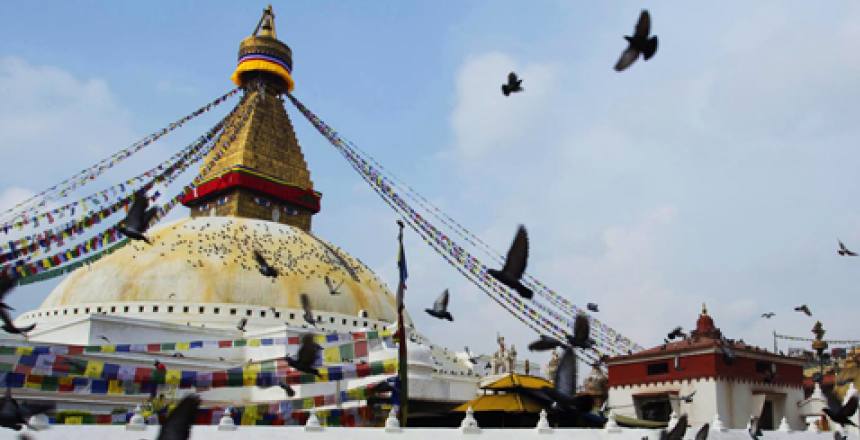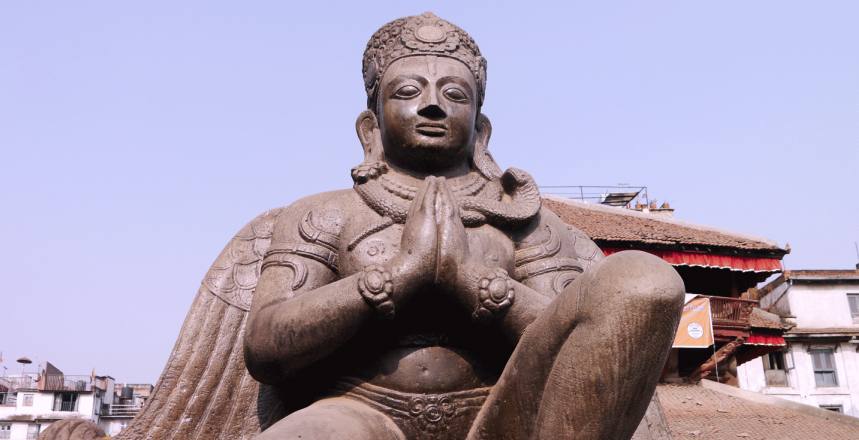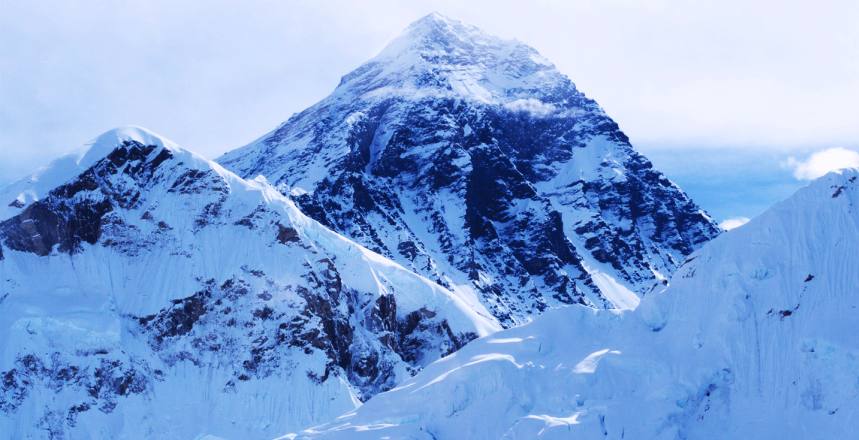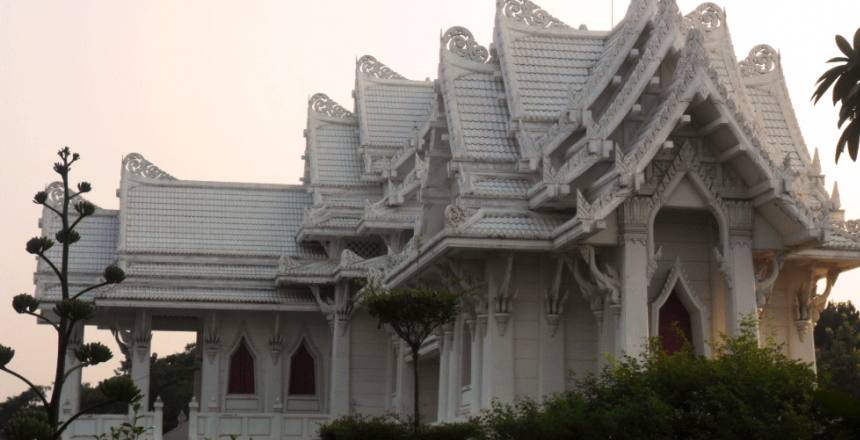World Heritage Sites of Nepal
WORLD HERITAGE SITES OF NEPAL
There are four UNESCO World Heritage Sites (WHS) in Nepal. Of these for WHS,-two are in the cultural category and two WHS fall in the natural category.
In the cultural category, the seven monuments of the Kathmandu valley (together counted as one WHS) and Lumbini – the birthplace of Lord Buddha are included whereas the other two WHS in the natural grouping is the Chitwan National Park and Sagarmatha National Park. The Kathmandu Valley WHS comprises of three historical palaces of Kathmandu Durbar Square, Patan Durbar Square and Bhaktapur Durbar Square, two Buddhist Stupas Swayambhu and Boudhanath, and two Hindu temples Pashupati and Changu Narayan. The densest concentration of these heritages sites can be found here owing to the cultural and political importance of the Kathmandu valley. All these monuments were designated as UNESCO World Heritage Sites in October 1979. Most of the places listed in the WHS were revered for thousands of years and there has been a series of contributions and renovations in the form of construction of temples, stupas, and places over the centuries by different rulers and kings. The WHS of Nepal is an expression of the finest sensibility of the history and lifestyle of Nepal and are a legacy of the Nepalese people to human civilization.
HISTORICAL BACKGROUND
The Kathmandu Valley civilization is around 3000 years old. It has been claimed that the valley was a large pond in the early geological period and it was only when the pond was drained that the valley was ready for human settlement. There is also a legend which reinforces the story that a certain Bodhistav called Manjushree came to Kathmandu Valley and cut the gorge in Chobar with his flaming sword and drained the water out of the valley making it ready for human settlement.
The fertile land supported large settlements and over the centuries different dynasties that ruled the valley patronized and urban civilization with its rich cultural heritage. Politically the present days Nepal was divided into petty principalities and the earliest ruling class of Nepal were the Gopalas, Mahispalas and Kiratas dynasties who were followed by Licchavi (185-750 A.D.). The Licchavi period is known as the classical period of Nepalese history because it was during this period that art and they built magnificent temples, palaces, and monuments.
But it was only under the later Malla period and the early Shah period from 14th to 18th centuries the Valley's fabulous cities with their exquisite pagoda, shikhara and stupa architecture, ornate palaces and artistic temples came to take shape in the form that we see it to day.
However the present day neoclassical buildings were built only during the second half to the 19th century (Rana Regime) with Nepal’s first contact with the western countries.
The historical monuments of the world heritage sites of Kathmandu valley are marked by the presence of three prominent architectural styles namely the Pagoda, Shikhara and the Stupa style. The pagodas are multi-tiered monuments tapering towards the top with intricate wood carving in the forms of doors, pillars, windows and struts, These ubiquitous wooden historical structures are supplemented by bronze works and stone sculptures together forming the squares and palaces with profuse representation of images of gods, goddesses, demons, beasts, mythical figures, kings and the ordinary human beings engaged in their day-to-day activities.
KATHMANDU DURBAR SQUARE
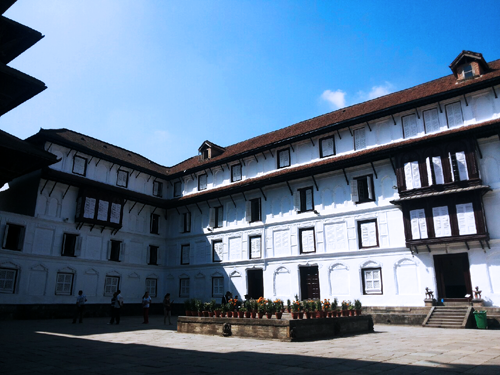 Kathmandu Durbar Square is in the heart of the Kathmandu city. The locals know this area by its old name Hanuman Dhoka- an ancient seat of Nepalese Royalty. The Royal Palace during medieval times were not merely for Royal activities but also used as the center of administration, cultural activities, and festivals.
Kathmandu Durbar Square is in the heart of the Kathmandu city. The locals know this area by its old name Hanuman Dhoka- an ancient seat of Nepalese Royalty. The Royal Palace during medieval times were not merely for Royal activities but also used as the center of administration, cultural activities, and festivals.
The historical buildings and temples in the area were erected from the time of King Ratna Malla (1484-1520 AD) to Prithvi Bir Bikram Shah (1875-1911 AD) covering the Malla, Shah and Rana period of Nepalese history. The entire palace complex here is named after a monkey god called Hanuman. One can see a huge stone statue of Hanuman painted all red next to the main entrance (the golden gate) of the palace. Hanuman here is regarded as a powerful protector of the entire Durbar Square.
Prominent Monuments:
Taleju Temple: The temple built by King Mahendra Malla in 1562 A.D. was dedicated to the royal deity of the Malla kings. Resting on a 12 stage plinth, the temple is 36.6 meters high. The temple is opened to the public just once in a year during Dashain festival (Sep-Oct).
Krishna Temple: This octagonal temple dedicated to Lord Krishna was built in 1649 A.D. by Pratap Malla in memory of his two dead queens. There is a mention in the epigraph that the temple contains the statue of the King and his queens representing as Lord Krishna and his consorts.
Jagannath Temple: The image of Jagannath was installed in 1563 A.D. during the reign of Mahendra Malla and the temple is famous for erotic carvings.
Stone Column: The stone Column represents the statue of King Pratap Mallain praying gesture to Goddess Taleju- the Royal Family Deity.
Degutalle temple: A Tantric goddess representing the family deity of the Malla kings is enriched in the temple and access is restricted to visitors. The temple lies opposite the Stone Column and was built in 1671 A.D. by King Shiva Singh and later renovated by King Pratap Malla.
Hanuman Statue: Kneeling Hanuman the monkey god, seated on a stone pedestal and flanked by a pair of lions symbolizes strength and protection against all possible threats. The Hanuman pedestal was erected by King Pratap Malla in 1672 A.D.
Shiva-Parvati Temple: The divine couple Shiva and his consort Parvati look out from the central window of the first floor. The temple was built during the reign of King Rana Bahadur Shah.
Big Bell: The bell erected in 1797 A.D. by King Rana Bahadur Shah is rung only when worship is begging offered in Degutalle temple situated nearby.
Kal Bhairav: Shiva in his ferocious form is known as Bhairav. This is one of the largest images of Bhairav and was erected by King Pratap Malla.
Maju Dewal: This temple dedicated to Shiva was built in the late 17th century by Queen Mother Riddhi Laxmi and rests on a nine Plinth base dominating the square and commanding a good view of the area.
Trilokya Mohan Narayan: This Vishnu temple of late 17th century near the Kumari Ghar, was built on a five stage plinth by King Prathibendra in memory of his deceased brother. There is a kneeling image of Garuda – the vehicle of Vishnu, near the temple. During Indrajatra (Chariot festival) large crowd gathers here to see the ten incarnations of Vishnu enacted on the pedestal.
Kumari Ghar: Kumari Ghar built in 1757 A.D. by King Jaya Prakash Malla is the house of the living goddess ‘Kumari’ who is believed to be the incarnation of goddess Taleju, the protective deity. Kumari often provides her blessing from the window to the visitors.
Basantapur Durbar: The Basantapur Durbar also known as Nau-table Durbar was built by King Prithvi Narayan Shah in 1770 A.D. Alongside there are other high standing pagodas known as Kirtipur Tower, Bhaktapur Tower and Lalitpur Tower
Gaddi Baithak: This neoclassical building was built by Chandra Shumsher in 1908 A.D. during the reign of King Prithvi Bir Bikram Shah. Such kind of buildings was constructed because of Nepalese contact with the west in the second half of the 18th century.
Kasthamandap: This 12th-century wooden building is said to be constructed from the wood of a single three hence Kathmandu obtains its name from this historical building, Kasthamandap. The building was used for public gathering during those days. The central image in the building consists of Gorakhnath and there are miniature temples of four Ganesha.
Ashok Vinayak: This temple dedicated to the elephant god Ganesha is revered both by the Hindus and Buddhists alike and is one of the most important shrines in the valley.
Dhansa: This temple was built in 1673 A.D. by Pratap Malla to start a new masked dance of Narasimha, an incarnation of Vishnu
PATAN DURBAR SQUARE
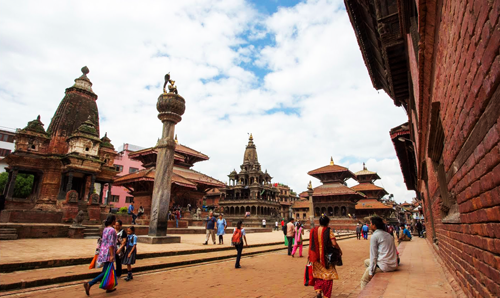 Patan is also known as Lalitpur which means the city of arts. It is located across the river Bagmati which is 5 km south of central Kathmandu. This city founded in 3rd century A.D. by King Veera Dev has the distinction of being the home of the finest crafts and is considered oldest of all three cities of Kathmandu Valley. Most of the monuments in this square date back to the medieval Malla period from 16th to the 18th century and the monuments in the area are mostly credited to King Siddhi near Singh Malla, Shri Niwas Malla, and Yog Narendra Malla.
Patan is also known as Lalitpur which means the city of arts. It is located across the river Bagmati which is 5 km south of central Kathmandu. This city founded in 3rd century A.D. by King Veera Dev has the distinction of being the home of the finest crafts and is considered oldest of all three cities of Kathmandu Valley. Most of the monuments in this square date back to the medieval Malla period from 16th to the 18th century and the monuments in the area are mostly credited to King Siddhi near Singh Malla, Shri Niwas Malla, and Yog Narendra Malla.
Main Chowk (Courtyards): Patan Durbar Square consists of three main courtyards – Mul Chowk, Sundari Chowk and Mani Keshab Narayan Chowk which houses the Patan Museum. The Sundari Chowk built by King Siddhi Narshing Malla in 1647 A.D. contains the master piece of stone sculpture known as the Royal Bath and was used for performing ritual bathing.
Bhimsen Temple: The three-storied temple of Bhimsen located in the extreme north of the square with the magnificent golden balcony overlooking the square outside is very popular amongst the local merchant and trader communities. There are curio shops around the temple.
Vishwa Nath Temple: This two-storied temple dedicated to Shiva located near the Bhimsen temple is built Pagoda style and houses a large phallic of Shiva and the temple is guarded by two elephants.
Krishna Mandir: the temple of Lord Krishna built in the 17th century by King Siddhi Narshingh Malla is the first specimen of Shikhara style temple entirely made of stone. It is the only temple in Nepal with 21 golden pinnacles and contains engraved scenes from the epics of Ramayana and Mahabharata.
Stone Colum: The Stone Column of King Yog Narendra Malla in a praying posture to goddess Taleju is protected by a snake above his head and a bird is seen seated on the snake. Legend says that the King would be remembered and remain immortal as long as the bird does not fly from there. It is because of this belief that a window of the nearby palace. A stone pillar located nearby with the Garuda atop facing the Krishna Temple is another typical example of Nepali stone workmanship.
Jagannath Temple: Also known as the Char Narayan temple and one of the oldest, this temple is located south of the Krishna temple. The temple is guarded by two lions and half human form sculpted in stone.
Harishankar Temple: This three-tier temple built in 1704 A.D. is dedicated to Shiva and Vishnu. This temple was built by the wives of King Yoga Narendra Malla after his death in his memory because of which this temple is also known as Sati temple.
Taleju Temple: There are prominent temples like the three-storied octagonal temple of Taleju Bhawani and Digu Taleju – the five Storied temple of the Protective deities built by King Siddhi Narsingha Malla in the 17th century. These temples are a unique example is located at a walking distance north from the main square.
Kumbheshwor: This five-storied temple dedicated to Shiva was built during the reign of King Jayastithi Malla in the late 14th century. It is a few minutes’ walk north from the main square. A religious fair is held during Janai Poornima (August). There is also a famous Banglamukhi temple nearby.
Mahaboudha: A Thousand images of Buddha are found in the temple made of fine quality bricks. The temple was constructed in the 15th by an architect named Avay Raj and is located eastwards within walking distance from the main square.
There are many other shrines, sculptures, stupas scattered in and around the square and provide a unique experience to visitors d art lovers.
BHAKTAPUR DURBAR SQUARE
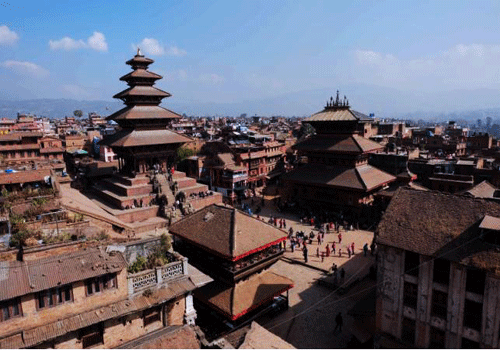 Bhaktapur meaning the city of devotees was founded by King Ananda Dev in 1197 A.D. according to the Gopal Raj Vamsabali even though the existence of the city could be traced back to the Lic Chavi period (185-750 A.D.). There are many monuments including pagodas, palaces, shikhara style monuments, courtyards and Buddhists shrines and monasteries, The Durbar Square was the seat of the Malla King and the present structures were erected from the 12th to the 18th century A.D. Bhaktapur is located at around 12 kilometers away from Kathmandu city.
Bhaktapur meaning the city of devotees was founded by King Ananda Dev in 1197 A.D. according to the Gopal Raj Vamsabali even though the existence of the city could be traced back to the Lic Chavi period (185-750 A.D.). There are many monuments including pagodas, palaces, shikhara style monuments, courtyards and Buddhists shrines and monasteries, The Durbar Square was the seat of the Malla King and the present structures were erected from the 12th to the 18th century A.D. Bhaktapur is located at around 12 kilometers away from Kathmandu city.
The Lion Gate: The two lions symbolize the elements of power and protection and was installed on its either sides during the reign of King Bhupatindra Malla in1696 A.D. This gate has beautiful stone statues of Bhairav- the fierce form of Shiva and Durga- the manifestation of Shakti- the female power.
Golden Gate: The Golden Gate was built by King Ranjit Mala in 1754 A.D. which serves as an entrance to the Taleju complex.
Four Pilgrimage sites: You can observe the four dhams (pilgrimage sites) of Jagannath, Kedarnath, Rameshwar, and Badrinath just at the entrance. It is a replication of holy sites revered in India.
Stone Column: King Bhupatindra Malla seated atop on a stone pillar in an attitude of prayer to Taleju Bhawani. He was a great builder, a scholar, and an artist.
55 Windows Palace: This is the supreme wooden architectural structure dominating the entire Durbar Square. This magnificent edifice was originally built by Yakshya Malla in 1427 A.D. and embellished later by Ghupatindra Malla in the 17th century.
Vastala Temple: It was built in Shikhara style completely of stones by Jaya Ranjit Malla in the 17th century A.D. The temple is dedicated to a mother goddess Durga. On the lower flank of the temple, there is a small bell knows as ‘basking bell’ because dogs bark and whine at the sound of the bell. In those days the bell was used as an alarm to alert the people during an emergency.
Yakcheswor Mahadev: This temple is the replication of Pashupatinath temple of Kathmandu. It was built by King Yakshya Malla in 1480 A.D. It shows the importance of Pashupati temple in the spiritual life of the people of Bhaktapur and it was built so that people from Bhaktapur may avoid the difficulty of going to main Pashupati in Kathmandu for offering prayers.
A folklore mentions that the king who was a great devotee of Lord Pashupati dreamt the Lord who told him to build a temple for him so that could move into it. He obeyed the divine command and thus the temple was built.
Taumadi Square
Nyatapola: The temple was founded by King Bhupatindra Malla in 1702 A.D. Nyatapola in Newari means five-tiered temple symbolizing the five basic elements of Nature. The temple is dedicated to Goddess Siddhi, Laxmi – a Tantric deity representing the most powerful female force. The legend goes that the temple was built by King the advice of the astrologers to pacify God Bhairav and maintain a harmonious balance of male and female principle. Nyatapola and Bhairav temples signify the coexistence of male and female energy pervading the earth.
The temple stands on the five plinths and rises above 30 m above the top plinth. Pairs of animals and robust men flanked the stairway. It is believed that every pair of the guardian is ten times more powerful than the pair immediately below. This is the most famous pagoda of Nepal.
Bhairav Nath Temple: This temple of Bhairav – the ferocious form of Shiva was originally built by Jagat Jyoti Malla as one storied temple and later King Bhupatindra Malla added two more stories to in 1718 A.D. According to a legend Vishwanath, a manifestation of Shiva once visited Bhaktapur to observe Bisket Jatra. When the locals recognize him they beheaded him in order to retain him permanently in the temple. It is because of this reason the central image of Bhairav temple has the head of Bhairav without the body and is taken on a chariot once during the Bisket Jatra which is the biggest festival of the town held in April.
Teel Mahadev Narayan Temple: South from Nyatopola lies this temple dedicated to Lord Vishnu building the 12th century A.D. A disc, lotus, conch-shell and mace-four emblems o Lord Vishnu are placed on pillars to the sides of the entrance.
Dattatreya Square
Dattatreya Temple: Dattatreya Temple, originally built by Yakshya Malla in 1427 A.D. and renovated by his son Vishwa Malla in 1458 A.D., is the only temple in Nepal that is dedicated to Lord Dattatreya-the combined incarnation of the three supreme gods-Brahma, Vishnu, and Shiva. The entrance of the temple is guarded by two robust men and in a stone, a pillar has placed a conch and a disc like a weapon dedicated to Vishnu. A bronze statue of Garuda the messenger of Vishnu is also erected on a stone column.
Bhimsen Temple: To the west of the Dattatreya temple is the Bhimsen temple built in 1605 A.D. Lord Bhimsen is the second oldest of the five Pandavas of the Mahabharat epic. In the olden day's people had to walk to Tibet or India for trade and pilgrimages, so one had to be naturally strong to embark on an arduous journey. In order to gain strength people prayed to Lord Bhimsen and the tradition continues till today. The area also has two bronze and wood carving museums and the famous window peacock an original masterpiece of Nepali wood work.
Pujari Math: The Pujari Math Literally translates as the Priest’s house now houses the wood carving museum. The Math built by King Yakshya Malla in the 15th century was used for storing donations and contributions. The world famous peacock window of the 15th century is situated on the eastern face of this house. One can observe intricately carved images of gods and goddesses on the struts of this monument.
PASHUPATINATH
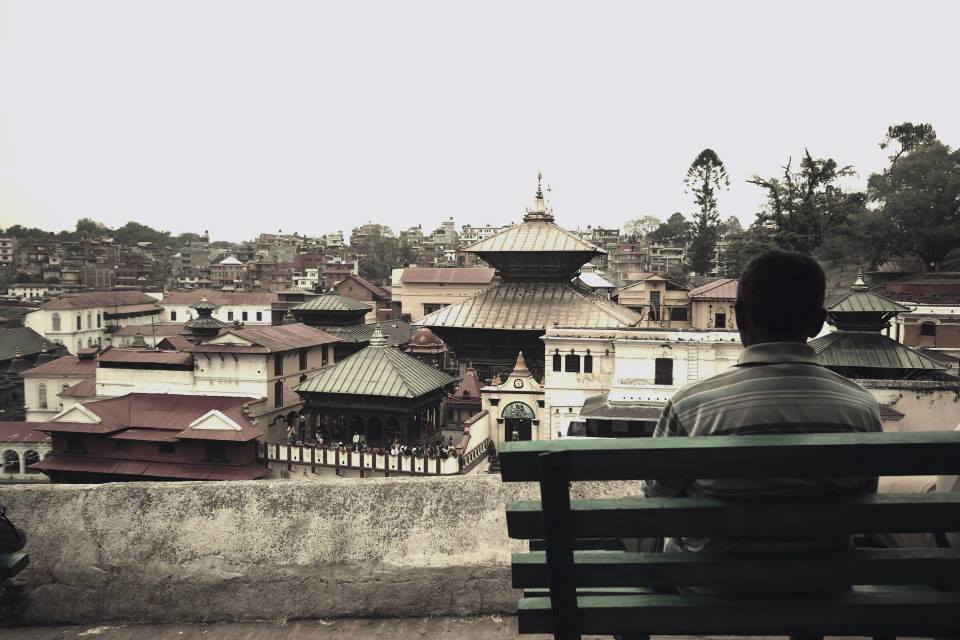
Situated 5 km east of Kathmandu city center, Pashupati literally means “Lord of Animals” and is considered to be the patron deity of Nepal. Pashupatinath is regarded as one of the holiest sites for Hindus all over the world.
Pashupatinath temple is a pagoda style two-tiered golden roof with exquisitely carved four silver doors containing in its sanctum a phallic idol with four faces facing each direction and the other fifth one is looking up toward the zenith. A temple dedicated to Shiva was constructed at the present site by Licchavi King Supushpa Verma according to an ancient chronicle. However, the present temple is claimed to have been built by King Bhupalendra Malla in 1697 A.D. Legend has it that a cow would frequently escape from its herds and offer milk on a Jyotirlinga (phallic symbol of Shiva) which denotes the point where the temple stands today. It is said that a certain cowherd much to his surprise found the self-generated Jyotirlinga (phallic symbol of Shiva) when he dug the spot where the cow would give milk. The spot immediately became the center of worship that has been continued till today.
Legend also mentions that the Pandavas after the great Mahabharata battle were told that only by sighting Shiva would they be absolved of their sins and it was at this very spot that they saw the Lord. Hence, this most sacred abode of Shiva, who is the God of the gods-Mahadeva-merits a visit by all Hindus, at least once in a lifetime, to be truly blessed and cleansed, it is believed that pilgrimage to the four dhams like Dwarka, Kedar, Rameshwar and Jagannath of India becomes meaningful only after a final darshan of Pashupatinath and by taking a holy dip in the Bagmati River and conducting a proper puja. There are temples of other Hindu deities in Pashupati premises like Bhairavnath, Vasuki nag, Parvati temple, Ram Mandir, Vishwa rup, Goraknath, Kirateshwor temple and dozens of temples dedicated to different gods and goddesses.
A considerable part of the temple vicinity is converted to rest and prayer areas. Behind the temple on the banks of Bagmati is a crematorium for Hindus. It is the wish of every Hindu to be cremated on the bank of the Bagmati River near the temple. At the other end of the Pashupatinath Temple area is the temple of Guheshwori dedicated to Shiva’s consort Parvati also known as Satidevi. There is also a deer park at the back of the temple across the Bagmati River. It is also interesting to watch the monkeys roam in and around the temple freely. One may also observe Sadhus smeared with ashes and dressed in lion-cloths and the Hindus Brahmins offering Tika and blessing to the visitors.
The Nepalese people also have a tradition of worshipping Pashupatinath as the Buddha. The rituals that take place particularly on Gurupumima (the full moon day in the month of July) on which teachers are honored and worshipped as equivalents of gods Lord Pashupatinath is the supreme Guru, and so is Lord Buddha-both of them teaching the value of love, humanity and universal peace. It is believed that Lord Pashupatinath holds the following five things very dear to him. The first thing is Gangajala (water from a river) with which his idol is bathed before worship. The second is Godugdha (cow’s milk) which is dripped on him through a small hole at the bottom of a round container hung over him. The third is the Vilva (wood apple, Aegle marvelous)leaves, which are offered loose or in wrath. The fourth is the Dhaturo (thorn apple), Datura metal) flowers or fruits. And the fifth is the Rudraksha (utrasum, Elaeocarpus spaericus) beads strung on a yellow thread.
Every year Mahashivaratri is celebrated with devotions, enthusiasm, and jubilation to the greatest day of Lord Shiva. It is the most important religious occasion to worship and pray. Mahashivaratri is the great night of Shiva people is towns and villages of Nepal celebrate the lion fire night. They light out floor holy fires sit around them and make a great time of rejoicing. The fires which begin after dusk and continue till about midnight are believed to bless those who are getting warm by the fires.
There are many other days, which are celebrated as occasions of great festivity at the Pashupatinath Temple. Two other them are mentioned there. One is Teej (in the month of August) which is celebrated by women only. Women go on a fast and observe an overnight visible around the temple, singing, and dancing. The other is Balachaturdashi (in the month of November)
SWAYABHUNATH
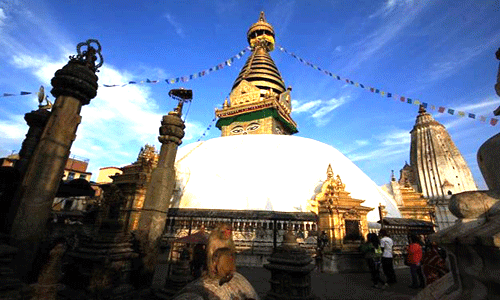
Located on a lovely little hillock, Swayambhunath Stupa lies about 4 km west of central Kathmandu. There are 360 steps leading all the way to the top commanding a magnificent view of Kathmandu valley and the breath-taking panorama of the snow-clad Himalayan range. The tradition in the Stupa follows the Vajrayana form of Buddhism which is a tantric variation of the Mahayana Buddhism (the great vehicle). The stupa seems to have been constructed during the Licchavi Period. Religious and literally sources give numerous accounts of the establishment and the patronage of the Swayambhunath premises. It is also interesting to note that the stupa went a series of renovation during the Malla period in the medieval times with donations made by merchants, monks, pilgrims and Buddhist followers.
As the ancient legend goes Kathmandu valley was a like long time ago. Right in the center of this lake was a full blown lotus with the divine light atop. When Maha Manjushri a saint from China heard about this he came all the way from China to the valley. He cut through the southern hill of the valley with his divine sword. The cleft made by the sword immediately drained the entire lake water making the valley floor ready for habitation. Hundreds of votive shrines and other historical monuments built in and around this stupa speak a lot about the significance and antiquity of this famed stupa. The Stupa of Swyambhunath stands on a typically stylized lotus mandala base. The hemispherical part of the chaitya is made of brick and stone and on top of the hemispherical part lies the hermika which carries the eyes of Vairochana watching in all the directions and believed to have been painted during the Malla period. The stupa is also laden with the 13 gold plated spires which symbolize the 13 stages to salvation. The spire is crowned by a golden umbrella supported by a pole from within the center. Devotees pour lime down the chaitya to cure the illness of family members.
Harati temple: It is two-tiered pagoda temple dedicated to the primal mother-Ajima who is also known as the protective deity of children. Special prayers are offered on Saturdays and Tuesdays.
Anantapur and Pratapaura: These two temples dedicated to Vajrayana deities were built by King Pratap Malla in the 17th century. Anantapura temple was named after his consort and both these temples represent the Shikhara style of architecture.
Bajra Dhatu Mandala: The Mandala depicts 12 animals representing the twelve months of the Tibetan year. The gilt Bajra installed by King Pratap Malla in the middle of the 17th century represents the sword Chandahasa of Manjushree.
Forms of Buddhas and their Consorts: The ten niches around the stupa represents the different forms of Buddha and their consorts. Clockwise representation is Aksobhya, Vairochana, Vajradhatvesvari, Mamaki Tara, Ratnasambhava, Pandara, Amitabha, Tara, Amogha Siddhi and Saptalochini.
The Vairochana is represented by the eyes painted on the hermika. Amitabha is the main deity of Chaitya.
Five Elements of Life: Temple and sacred sites representing the five fundamental elements of nature are said to have been founded by Shantikar Acharya. The five elements of life represented in the premise of the Stupa are Vasupura (earth), Nagapura (serpents, the lord of water), Shantipura or Akashpura (space or sky), Vayupura (air) and Agnipura (Fire).
Importance Days to Visit this Holy Site:
- Buddha Purnima, the birthday of Lord Buddha which falls on the full moon day of Baisakh (April-May)
- Gunla, the holy Buddhist month according to Newari calendar (Aug-Sep, early morning)
- Kojagrath Purnima (Sep-Oct), Samyak day of Magh (Jan-Feb) (once in every twelve years)
- Lhosar
BOUDHANATH
Boudhanath, the biggest stupa of Nepal, is located 5 km east of central Kathmandu. The stupa stands on a three-tiered platform raised over the crossed rectangles in order to bring out the yatra form. The claims made in various religious and literary texts regarding the erection of the stupa are varied and conflicting. However, the stupa is believed to have been built in the 5th century A.D. during the reign of the Licchavi Kings.
As in other stupa architecture, this stupa also has Vairochana at the center followed by Aksobhya, Ratna Sambhava, Amitabha and Amogha Siddhi in east, south, west and north directions respectively. Similarly, there are one hundred and eight small niches around the stupa accommodating the icons of Buddhas, Bodhisattvas and other female deities along with conjoint figures in erotic poses. Likewise, at the bottom level, it is surrounded with the praying wheels embossed with the famous mantra Om Mani Padme Hum fixed in more than hundred and forty inches.
According to a very popular legend, in ancient time there was a poor girl in a Magat village of Nepal. She was called Jyajima and was very pious and charitable by nature. She had a deep desire to spread the faith of the Master and approached the King for a piece of land where she could build a stupa. Hence she built the stupa with the help of her four sons as it stands today.
According to another very popular legend, in the ancient days, Kathmandu valley was under severe drought and this causes the King Dharma Dev much concern and anxiety. Finally, the King was advised by an astrologer that only the sacrifice of an ideal man with 32 virtues in front of the dry royal water could bring rainfall in the country. There was hardly anybody with such a great virtue except the King himself. So the following night he commanded his son to go to the dry water spout near the royal palace at mid night and behead the person clad in a white robe without looking at him. The Prince (Mandev the Licchavi King) obeyed his father and to his great horror found that it was none other than his own father that he beheaded.
In order to atone for the heinous sin, he prayed to goddesses Vajrayogini who ordered him to erect a stupa and practice rigorous penance. He practiced great penance in Gumvihar where Vajrayogini rests and it was due to his great devotion there sprang out the present stupa of Boudhanath.
Oldfield an Orientalist has written that a Lama from Tibet had died on his pilgrimage to Nepal and the stupa was erected with his relics and named it as Khasa Chaitya after his name.
During Buddha Jayanti (birthday of Lord Buddha, April-May) on the full moon day, a religious procession takes place with the icons of Buddha on a chariot. During Lhosar festival (Jan-Feb) the pilgrims worship the Buddhist deities, light the incense and butter lamp day and night. On the full moon day of Janai Purnima (sacred thread festival, Aug-Sep) the stupa is decorated with prayer flags and lights. Every twelve years a special ceremony is also observed denoting the fact that it took 12 years to build the stupa. Some Buddhist texts also mention that it took 2555 days (7 years) to complete the construction of the stupa. Dance, musical instruments, chant, and hymns are performed to mark the event with great festivity. The stupa along with the monasteries as centers of learning, cultural activities, prayers, and meditation.
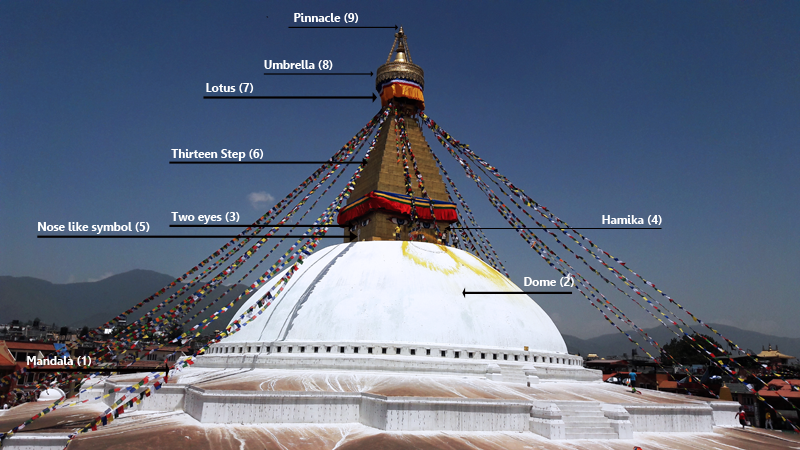
Meaning of the different parts of Boudha Stupa
- Mandala: Mansion of Buddha.
- Dome: Symbol of Universe or vase of great treasure.
- Two Eyes: Symbol of method and wisdom.
- Harmika: Symbol of eight noble paths.
- Nose like Symbol: Symbol of Nirvana.
- Thirteen Steps: The thirteen states of Bodhisattvas' ground for the complete enlightens.
- Lotus: Symbol of compassion and purity.
- Umbrella: Protector of three jewels Buddha, Dharma and
- Pinnacle: Symbol of Mt. Sumeru (The king of the mountains)
CHANGU NARAYAN
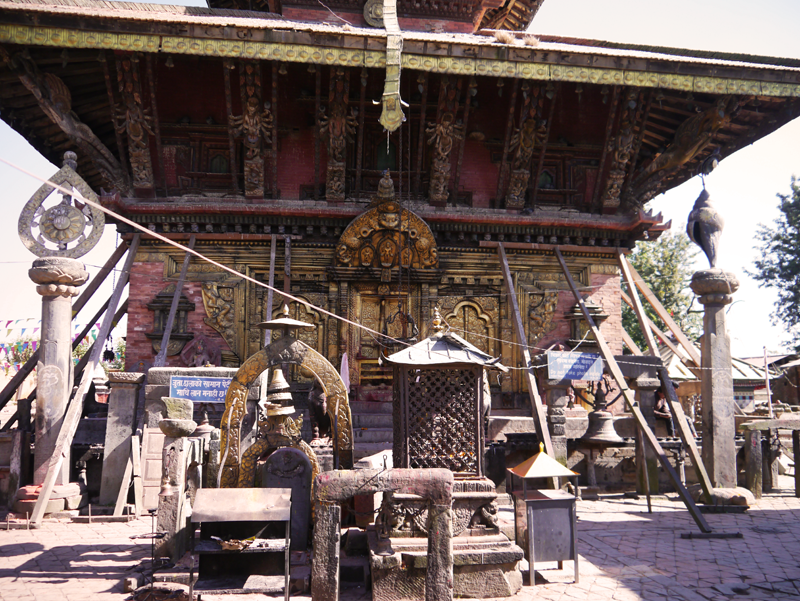 Located on a magnificent hill top commanding a fantastic view of Kathmandu valley, Changu Narayan the temple of Lord Vishnu lies 6 km north of Bhaktapur. The temple is full of magnificent art works in metal and wood in metal and wood. In fact, it is one of the finest examples of Nepalese architecture. The first epigraphic evidence of Nepalese history found in the temple premises during the reign of the Licchavi King Mandeva dating back to 464 A.D. shows that Changu had already been established as a sacred site in the 3rd century A.D. The present structure was probably constructed in the 17th century, though older elements have been incorporated during the restorations. The pagoda style temple has several masterpieces of 5th and 12th-century Nepalese art.
Located on a magnificent hill top commanding a fantastic view of Kathmandu valley, Changu Narayan the temple of Lord Vishnu lies 6 km north of Bhaktapur. The temple is full of magnificent art works in metal and wood in metal and wood. In fact, it is one of the finest examples of Nepalese architecture. The first epigraphic evidence of Nepalese history found in the temple premises during the reign of the Licchavi King Mandeva dating back to 464 A.D. shows that Changu had already been established as a sacred site in the 3rd century A.D. The present structure was probably constructed in the 17th century, though older elements have been incorporated during the restorations. The pagoda style temple has several masterpieces of 5th and 12th-century Nepalese art.
Some of the important sculptures here are:
- Viswo Roop Lord Vishnu in his all-pervasive universal form Vishwo Roop represented in a serpent bed the symbol of the endless water. This sculpture dates back to 8th century A.D.
- Vishu Vikaranta Lord Vishnu in his most powerful form measuring the space by his feet. The stone bas relief image is dated back to 8th century A.D.
- Vishnu mounted in his vehicle Garuda the mythical man bird.
- Nr-Singha Vishnu in his half human and half lion’s form.
The myth behind the conception of the Changu Narayan Temple portrays the religious significance and importance of the place. According to a legend, Lord Visnu beheaded a Brahmin thinking it to be a demon and only discovered it later that he had committed a heinous crime. He then wandered on earth on his mount, the ‘ Gauda’ eventually descending on the hill at Changu. There he lived in anonymity, surviving on milk stolen from a cow belonging to a hermit sage called Sudharshan, When Sudharsan noticed about the stolen milk, he attacked and beheaded Lord Vishnu which freed Lord Vishnu from his sins. Ever since that day, the site has been held sacred and the temple has been revered.
LUMBINI-BIRTHPLACE OF LORD BUDDHA
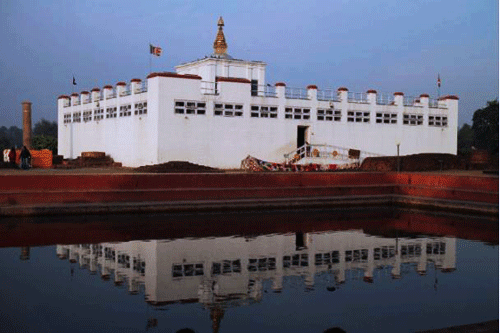 Buddha was born in Lumbini in southern Nepal on full moon day in 623 B.C. The importance of Lumbini is testified by the Mauryan Emperor Ashoka who visited Lumbini in order to pay homage to the great Master and erected a pillar in 249 B.C. to indicate the birthplace of Buddha. Near the Ashokan pillar is the newly renovated Mayadevi Temple which houses the Nativity sculpture depicting the birth scene of the Buddha. The temple also houses The Marker Stone discovered in 1996 A.D. which depicts the exact spot where the Buddha was born is now kept in bulletproof glass in the Mayadevi Temple.
Buddha was born in Lumbini in southern Nepal on full moon day in 623 B.C. The importance of Lumbini is testified by the Mauryan Emperor Ashoka who visited Lumbini in order to pay homage to the great Master and erected a pillar in 249 B.C. to indicate the birthplace of Buddha. Near the Ashokan pillar is the newly renovated Mayadevi Temple which houses the Nativity sculpture depicting the birth scene of the Buddha. The temple also houses The Marker Stone discovered in 1996 A.D. which depicts the exact spot where the Buddha was born is now kept in bulletproof glass in the Mayadevi Temple.
The Mayadevi Temple was renovated in 2003 on the 2547th auspicious birth anniversary of the Buddha and houses ruins of the early period dating back from 3rd century B.C. to the 7th century A.D. Near the temple is situated the Puskarni pond where
Queen Mayadevi-Buddha’s mother-had given the first purificatory bath to the infant Buddha.
In 1896, excavation’s by General Khadga Shumsher Rana of Nepal and renewed archeologist Dr. A Fuhrer shed light on various aspects of the life of Buddha. In 1898, the British government deputed P.C. Mukherjee who confirmed the exact location of Aurorakot as the birth place of Kanakmuni Buddha and Gotihawa as the native place of Kakruchhanda Buddha who existed before the Shakyamuni Buddha and Lumbini as a birthplace of Shakyamuni Buddha. He also claimed Devdaha to be the maternal home of Buddha and Tilaurkot to be the exact site of Kapilvastu – the ancient capital of the Shakya Kingdom.
Shortly after the Buddha attained enlightenment at the age of 36, he delivered his first sermon, in which he laid out the essential framework upon which all his later teachings were based. This framework consists of the Four Noble Truths and the Eight fold path, which identifies the sources of sufferings and the path towards the cessation of sufferings and the attainment of Salvation.
In order to develop Lumbini as a pilgrimage center and a fountain of World Peace, Prof. Kenzo Tange of Japan was assigned to create the Lumbini Master plan by UN which was jointly approved by the Government of Nepal and UN in 1978. The Master Plan includes canals, gardens, library, museum, monastic zones and areas for amenities. Lumbini Development Trust is responsible for the overall development of Lumbini listed as a World Heritage Site by UNESCO in December 1997, Lumbini is being developed with international support. There are different Vihars and Monastries constructed by different countries like Korea, Myanmar, Thailand, Vietnam, Cambodia, Japan, Germany, France, Austria, India, Srilanka, China, and Nepal.
General Information
Access: From Kathmandu, fly to Gautam Buddha Airport in Bhairahawa (30 minutes) and then drive (22 km) to Lumbini. Overland from Kathmandu to Bhairahawa is 300 km (9 hours)
Getting around: There are manual three - wheelers to get around the Lumbini complex.
Climate: Temperature 40 degree Celsius maximum, 7 degree minimum. Te rainy season lasts June-September.
Attractions: Lumbini tour, Buddhist circuit tour, Village tour, Monastery tour, Meditation, Archaeological tour, Crane Sanctuary, and Wet-land tour. Great celebration takes place during Buddha Purnima (April-May)
CHITWAN NATIONAL PARK (932 SQ.KM.)
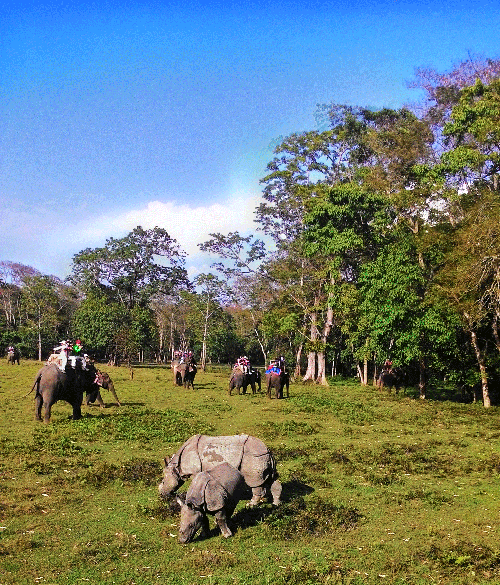 Chitwan National Park is established in 1973 was declared UNESCO Natural Heritage Site in 1984. The park that includes in its area a part of the Hivalik hills is covered with deciduous forest overlooking the floodplains of Narayani, Rapti and Reu rivers and offering a wilderness of rich ecosystem that includes mammals, birds, reptiles and water animals of several kinds. There are around 600 plant species, 50mammalss, 526 birds and 49 amphibians reptiles found in this park. The highlights, of course, are the One-Horned Rhinoceros and Royal Bengal tigers that live in the dense forest of the park. Sharing home in this park are other animals like rhesus monkey, grey langur, deer, leopards, white stocking gaur, wild boar, wild dogs and wild cats, Among reptiles are different kinds of snakes including the python, while the river areas breed amphibians like the endangered snouted gharials popularly known as Gangetic crocodile and marsh crocodiles. The forest is alive during summer with the arrival of migrant birds like paradise flycatcher, Indian pitta, and parakeets, while winter birds include waterfowl, Brahminy ducks, pintails, bar-headed geese, cormorants and migratory birds from Siberia. Other bird varieties are woodpeckers, hornbills, peacocks, peahens, floricans and redheaded trogons. A rare attraction of the park is the world’s fresh water dolphin variety sometimes seen in River Narayani. Another factor adding district touch to the Chitwan experience is the colorful Tharu culture. There are also sites of the religious and historical importance of Devghat, Pandavnagar, Balmiki Ashram and Kabilaspur.
Chitwan National Park is established in 1973 was declared UNESCO Natural Heritage Site in 1984. The park that includes in its area a part of the Hivalik hills is covered with deciduous forest overlooking the floodplains of Narayani, Rapti and Reu rivers and offering a wilderness of rich ecosystem that includes mammals, birds, reptiles and water animals of several kinds. There are around 600 plant species, 50mammalss, 526 birds and 49 amphibians reptiles found in this park. The highlights, of course, are the One-Horned Rhinoceros and Royal Bengal tigers that live in the dense forest of the park. Sharing home in this park are other animals like rhesus monkey, grey langur, deer, leopards, white stocking gaur, wild boar, wild dogs and wild cats, Among reptiles are different kinds of snakes including the python, while the river areas breed amphibians like the endangered snouted gharials popularly known as Gangetic crocodile and marsh crocodiles. The forest is alive during summer with the arrival of migrant birds like paradise flycatcher, Indian pitta, and parakeets, while winter birds include waterfowl, Brahminy ducks, pintails, bar-headed geese, cormorants and migratory birds from Siberia. Other bird varieties are woodpeckers, hornbills, peacocks, peahens, floricans and redheaded trogons. A rare attraction of the park is the world’s fresh water dolphin variety sometimes seen in River Narayani. Another factor adding district touch to the Chitwan experience is the colorful Tharu culture. There are also sites of the religious and historical importance of Devghat, Pandavnagar, Balmiki Ashram and Kabilaspur.
Activities: Jungle safari on elephant back, jungle walk, canoe ride, jeep drive and observation of Tharu culture.
Access: The park headquarters’ at Kasara is a 21-km drive from Bharatpur, which is 20 minutes by air or 146 km by road from Kathmandu.
Best Season: Oct-Feb (average temperature 25 degree Celsius): Mar-Jun (hot, up to 43 degrees Celsius), July-Sep (rainy)
SAGARMATHA NATIONAL PARK (1148 SQ.KM.)
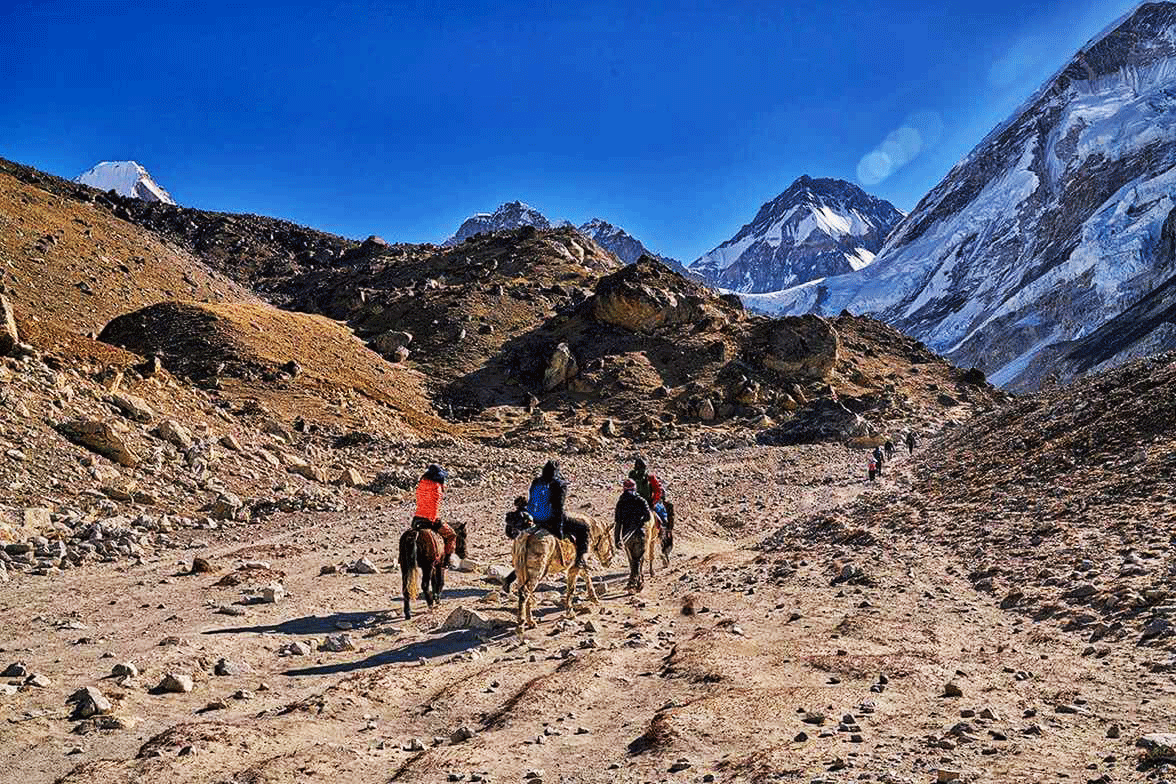
The prime attraction of Sagarmatha National Park established in 1976, is Mt. Everest the highest peak in the world. The park was added to the list of World Heritage Site in 1979. The park, a part of the Himalayan ecological zone, has several other prominent peaks most of which are above 6,000 meters. With most of the park above 3,000 meters, Sagarmatha is full of rugged terrain with deep gorges, glaciers and huge rocks. With its Himalayan terrain and its culture, the parks offer a blend of natural and cultural tourism products. The vegetation at the lower elevation is dominated by pine and hemlock forest, while above 3,500 meters the forest is dominated by silver fir, birch, rhododendron and juniper trees. During spring and monsoon, the varieties of rhododendron flowers are seen. The common wild life in the park is Himalayan Tahr, ghoral, musk deer, pikka (mouse hare) weasel and jackal. Other rarely seen animals are Himalayan black bear, wolf, lynx and snow leopard. Birds inhabiting the parks are of over 118 species. Common ones among them are the impeyan pheasant (Danphe), blood pheasant, red billed cough, yellow billed chough, snow-cock, snow pigeon, Himalayan griffon, and lammergeyer. The area also provides warm Sherpa hospitality and has many monasteries and cultural landmarks. Tourism activities and farming are the main activate of the area. Growing barleys and potatoes and raising Yaks are some of the notable occupations. The majority of the youths are engaged as mountaineering and trekking guides in the season.
Fact Sheet
|
Sagarmatha Nation Park and Buffer Zone |
|
|
National park declared year |
July 19, 1976, AD |
|
National park area |
1,148 km2 |
|
Location |
North-eastern Nepal (Solukhumbu District) |
|
World heritage site listed |
1979 (Natural Site) |
|
Ramar site declaration |
2007 (Gokyo and associated lakes) |
|
Bioclimatic Zone |
Temperate-alpine-Nival zone |
|
Elevation |
2,300 m – 8,848 m above msl |
|
Major geophysical characteristics |
Mt. Everest Region, Glaciers, Valley |
|
Major glaciers |
Khumbu, Lmja, Ngozumpa, and Nangpa |
|
Major peaks |
Sagarmatha (8,848m), Lhotse (81,501m), Cho Oyu (8,153m), Nuptse (7,896m) |
|
Main mammals |
Snow Leopard, Musk Deer, Red Panda |
|
Main birds |
Himalayan Monal, Blood Pheasant |
|
Major tree species |
Pine, Hemlock, Fir, Juniper, Birch |
|
Buffer zone declared |
January 1, 2002, AD |
|
Buffer zone area |
275 km2 |
|
VDC’s |
3 VDCs, (Chaurikharka, Namche, Khumjung) |
|
Population |
7,745 |
|
Major caste groups |
Sherpa, Tamang, and Rai |
|
Economy |
Tourism, agriculture, animal husbandry, business, mountaineering |
Major Attractions
- The world’s highest peak Mt. Everest (8,848m above mean sea level)
- Two other peaks (Lhotse and Cho Oyu) higher than 8,00m. Mt. Everest Base Camp and Kala Patthar
- Gokyo lake and glaciers
- Chukung and Thame Valley
- Snow Leopard, Musk Deer, Red Panda and Himalayan Monal
- Sherpa culture and Monasteries
Activities: Trekking, Mountaineering, cultural observation, and Meditation.
Accommodation: Resort, hotels, lodges, camping
Access: Namche bazaar, the gate way to Everest region, is a two-day walk from Lukla which is 30 minutes by air from Kathmandu.
Best Season: Oct-Nov and Mar-May, Dec-Feb (snow, daytime temperature 5 degree Celsius), Jun-Sep (rainy)
Trekking Routes
The trek from Namche to Kala Pathar is very popular. The Gokyo Lake and Chukung Valley provide views. The Thame Valley is known for its Sherpa culture while Phortse is famous for wildlife viewing. There are some high passes worth crossing over. However, trekkers must have a guide and proper equipment for the trek.
Safety Precautions
High altitude sickness can sickness can affect you if elevation is gained too rapidly and without proper acclimatization. The symptoms are rapidly and without proper acclimatization. The symptoms are a headache, difficulty in sleeping, breathlessness, loss of appetite and general fatigue. If someone develops such symptoms, stop ascending immediately. If symptoms persist, the only proven cure is to descend to a lower elevation. Medical advice can be sought at the Khunde Hospital and Namche or Pheriche Health Post.
General Code of conduct
Follow the minimum impact code while trekking so that you and your host (local nature and people) benefit for indefinite years to come. Because what you benefit from a particular tourism destination at present and future largely depends on how you impact the local environment and culture.
Conserve Forest
- The use of firewood is prohibited.
- Don’t light campfire; Cook with kerosene or gas and take sufficient warm clothing.
- Choose lodges that use alternatives to fuel wood for cooking and heating.
- Kerosene/gas could be bought from depots at Syangboche, Dole, and Phortse.
- The purpose of the depots is to encourage private hotel/lodge owners to use kerosene/gas as an alternate source of energy and help conserve the alpine vegetation.
Stop Pollution
- Carry out what you carry in.
- Buy only what won’t pollute, or carry it out
- Use safe drinking water (ozonized) or purify water yourself.
- Minimize the use of polythene/plastic materials.
Park Regulations to follow or things to remember
- An entry fee of RS. 3,000 (foreigners), RS 1,500 (SAARC) and additional VAT must be paid at the designated ticket counter per person.
- Valid entry permits are available from the National Parks ticket counter at the Nepal Tourism Board, Bhrikuti Mandap, Kathmandu or park entrance gate at Monjo.
- The entry permit is non-refundable, non-transferable and is for single entry only.
- Entering the park without a permit is illegal. Park personnel may ask for the permit, so visitors are requested to keep the permit with them at all times.
- Get a special permit for documentary filming from Department of National Parks and Wildlife Conservation.
- Don’t injure, kill or uproot plants and animals. Don’t buy a wild animal or plant products. It is illegal. All flora and fauna are fully protected and must not be disturbed.
- Rubbish must be placed out, buried or disposed of in designated areas.
- No one should walk within the park between sunset and sunrise.
- Do respect cultural and religious sites.
- Visitors should be self-sufficient in fuel supply (kerosene/LP gas).
- Camping inside the park should be done only in designated areas.
- Carry out non-bio degradable items such as batteries, plastic bag, and bottles.
- Mountain bikes and motor bikes are prohibited inside the park.
- Never trek alone, hire a local guide if you can’t find a companion.
Reference from Nepal Tourism Board and Department of National Parks and Wildlife Conservation
- We love to talk adventures, speak to one of our trekking experts now!
- +977 9841326314
.png)
